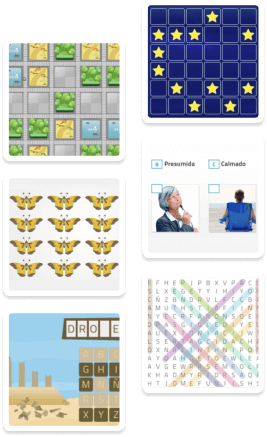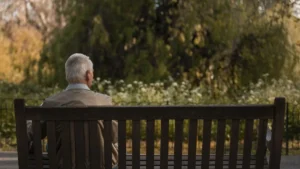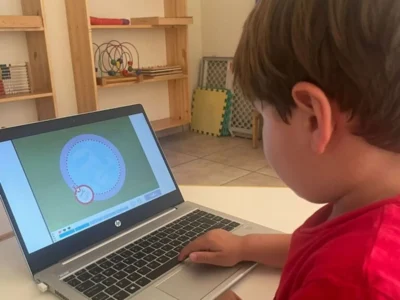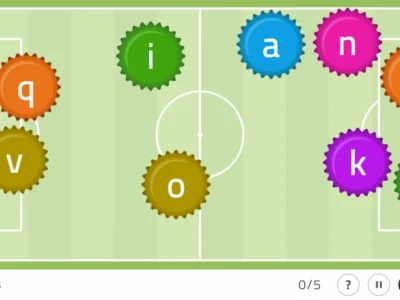The coordinator of social intervention projects aimed at older adults at the Asociación para la inclusión Acompáñame, Cristian Macía Rojas, tells us in this article about how to combat unwanted loneliness in older adults.
Loneliness is a universal human feeling that we all experience at some
point in our lives. However, when it becomes chronic and unwanted,
it can have devastating consequences for health and well-being, especially in older adults. Loneliness in later life is a growing problem worldwide, and it is essential to address it effectively to improve the quality of life of our loved ones at this stage of life.
In this blog post, we will explore in depth the topic of unwanted loneliness in older adults, its causes and effects, and how through NeuronUP as an innovative tool it can be an effective solution to combat this problem.
Throughout this article, you will learn about the importance of addressing loneliness in
older adults and how at Asociación para la inclusión Acompáñame we use
a working methodology where an individualized, participatory and healthy intervention model is established where NeuronUP has become an invaluable ally in this effort.
The World Health Organization defines aging as:
“The physiological process that begins at conception and causes changes in the
characteristics of species throughout the life cycle; these changes produce
a limitation in the adaptability of the organism in relation to the environment. The rates at
which these changes occur in the various organs of the same individual or in
different individuals are not the same” (WHO, 2002).
Moreover, according to Hernando (2006), aging does not have a single responsible mechanism, but is due to the accumulation of various interactive causes among
themselves; also, according to Hernández y Martínez-Esparza et al (2006), the concept of
aging is established as the grouping of various modifications developed in the person during their life cycle, this being a result of the effect of the passage of time on people, producing changes at biochemical, physiological, morphological, social, psychological and functional levels
Loneliness in older adults : A silent problem
Unwanted loneliness in older adults is a problem that often goes
unnoticed. Many older adults may find themselves alone due to various
circumstances, such as retirement, the loss of loved ones, decreased
mobility or a lack of connection with the community. Loneliness can affect anyone, regardless of marital status or economic situation, and is not always evident to others.
According to Bourdieu (1991), he presents aging as a work with a sociocultural character, where identities, roles and structure are assumed by the different social groups, developing significant inequalities among them. Also, Izquierdo (2010)
contributes to the definition of this concept by insisting on the concept developed by
Bourdieu earlier, pointing to age as a social and cultural construct
producing a separation during the course of the life cycle into various
moments that are differentiated from one another.
Causes of loneliness in older adults
- Loss of loved ones: The loss of friends and family is one of the
main causes of loneliness in older adults. As we age, it is natural for our loved ones to pass away, which can
leave an emotional void that is difficult to fill. - Retirement: Retirement, although it can be an expected and welcome time,
can also lead to loneliness. Many older people find that the daily routine provided by work disappears, and they may feel lost without a clear purpose. - Mobility problems: Decreased mobility due to health issues or disabilities can lead to loneliness by limiting older people’s ability to participate in social activities.
- Lack of support network: Some older adults may lack a strong social
support network due to the geographic distance of family and friends, or
because they have lost contact with their community. - Ageism: Society often perpetuates negative stereotypes about
aging, which can lead older people to feel marginalized or undervalued
Effects of loneliness in older adults
Aging is categorized as an irreversible, intraindividual and universal process; within what was previously developed it has been established that the human being is a dynamic entity composed of different parts such as: the biological, psychological and social.
Unwanted loneliness in older adults can have a number of harmful effects on their
physical and emotional well-being. Some of the most common
effects include:
- Mental health problems: Loneliness can contribute to depression, anxiety and other mental health disorders in older adults.
- Physical health problems: various studies have shown that lonely older adults have a higher risk of developing cardiovascular diseases, hypertension and diabetes.
- Isolation: Loneliness can lead to social isolation, which in turn can
worsen mental health problems and make it harder to manage chronic illnesses. - Decreased quality of life: Loneliness can reduce the quality of life
of older adults by affecting their overall life satisfaction and sense of purpose.
NeuronUP: An innovative tool to intervene on unwanted loneliness in older adults
Loneliness in older adults is a complex problem that requires multifaceted approaches
for intervention. One of the most innovative and
effective tools that has emerged in recent years is NeuronUP.
This digital platform has become an indispensable resource in the fight against unwanted loneliness in older adults. In addition, this application allows us to work cross-sectionally on other skills such as the digital divide, enabling us to bring ICTs closer to older adults, promoting or resuming new or old social relationships focused on technological communication that for various reasons had been lost.
NeuronUP works on different cognitive functions according to the user’s needs, therefore, for Asociación Acompáñame it allows great flexibility to
adapt to the characteristics and conditions of each of our beneficiaries, promoting active aging and preventing DCL and/or working with different neurodegenerative diseases at their various stages.
In addition, digital tools help preserve the environment thanks to the
reduction of paper use for developing session records. At Asociación para
la inclusión Acompáñame we try to develop the maximum number of Sustainable Development Goals possible. We are fully committed to environmental conservation. Therefore, using a digital tool that allows us a great variability when programming different sessions with various activities through a tablet or portable device helps us meet our objectives and values.
How NeuronUP addresses unwanted loneliness
NeuronUP addresses unwanted loneliness in older adults in several key ways:
- Variety of activities: The platform offers a wide variety of
activities designed to stimulate different cognitive areas, such as
memory, attention, problem solving and visual perception. This
variety ensures that older adults remain engaged and
enjoy a diverse experience. - Personalized programs: NeuronUP allows users and health professionals to
create personalized cognitive stimulation programs. This means
that activities can be adapted to the individual needs and preferences
of each older person, which increases the likelihood of
participation and engagement. - Monitoring and evaluation: NeuronUP allows precise monitoring of
each user’s progress. This feature is essential to adapt activities as cognitive needs change and to measure the
impact of the intervention on loneliness and overall well-being. - Accessibility: NeuronUP is an online platform, which means it is
accessible from electronic devices such as tablets and computers. This
makes its use easier for older adults, even if they are not familiar
with technology.
Examples of activities in NeuronUP
- Logic and problem-solving games: these challenging games stimulate
the mind and encourage problem solving. Users can face puzzles or activities that require strategic planning. - Memory exercises: this type of activity helps older adults to
exercise their short- and long-term memory. Exercises can include remembering sequences of numbers or letters, matching images or completing puzzles that require recalling details. - Visual stimulation and perception: to keep the mind active, NeuronUP
offers visual stimulation and perception exercises, such as spotting differences
in images or recognizing visual patterns. - Attention training: Attention is a key cognitive skill.
NeuronUP offers activities that help older adults improve their
ability to concentrate and pay attention, which can be beneficial for
reducing the feeling of loneliness by being more present in their interactions
social.

Access thousands of exercises on our platform
The importance of addressing unwanted loneliness in older adults
The medical and technological advances have led to a decrease in mortality among
older adults, causing a notable increase in life expectancy.
We have gone from presenting values for men in 2004 of 77 years to 80.2 years in 2021. In the case of women the trend is similar, since we have gone from an average life expectancy in 2004 of 83.6 years to values of 85.8 years in 2021 (INE, 2022). Currently, we find very significant percentages within the population pyramid where the concentration of people over 65 stands out.
Unwanted loneliness in this population group conditions and further aggravates the
current public health problems that should not be overlooked. As the
population ages worldwide, it is essential to address this problem effectively to improve the quality of life of older adults and reduce the impact
on public health in general.
Benefits of addressing loneliness in older adults
By addressing loneliness in older adults, we can achieve the following benefits:
- Improved mental health: Reducing loneliness can help prevent and treat
depression and anxiety in older adults. - Improved physical health: By reducing social isolation, physical health problems associated with it, such as cardiovascular diseases and diabetes, can also be reduced.
- Higher quality of life: Older adults who feel more connected
to others tend to experience greater life satisfaction and a greater
sense of purpose. - Less pressure on health systems: By addressing loneliness, visits to hospitals and the need for medical care can be reduced, relieving
the burden on health systems.
How to use NeuronUP to address loneliness in older adults
- Personalize programs: work with your patients to create personalized intervention programs.
- Familiarize yourself with the platform: Explore the platform and become familiar with the
activities and exercises available. Understand how they can be adapted to individual needs. - Track progress: Use NeuronUP’s monitoring and
evaluation tools to measure progress over time. This will allow you to
adapt activities as needed. - Encourage participation: Encourage the older person to use the platform
regularly. You can set participation goals and rewards to
maintain motivation
Conclusions
Unwanted loneliness in older adults is a significant problem that affects physical and mental health of those who experience it, being a group with very
vulnerable conditions. Therefore, it is essential to address this problem effectively to improve the quality of life of older adults and reduce the burden on health systems.
NeuronUP has become a tool very valuable in this fight to which Asociación para la inclusión Acompáñame contributes. NeuronUP offers us a wide range of cognitive stimulation activities and promotes social interaction, as well as often having a very playful pedagogical approach for the beneficiaries.
Loneliness does not have to be an inevitable part of aging. With
tools like NeuronUP we can provide older adults with the
resources and support they need to keep their minds active and connect with others.
As we continue to explore new ways to address loneliness
in older adults, it is important to take advantage of the innovative technologies that
can make a difference in the lives of those who need it most. NeuronUP is an
example of how technology can be an ally in promoting well-being and
reducing loneliness in older adults.
Bibliography
– Bourdieu, P. (1991). El sentido práctico.
-Hernando Ibeas, M.V. (2006). Teorías sobre el fenómeno del envejecimiento. Envejecimiento activo, envejecimiento en positivo. Universidad de la Rioja, 37- 64.
– Hernández Martínez-Esparza, E., Barquín Arribas, M., Mundet Riera, I., Royano Reigadas, L., & García Calderón, M. (2006). La necesidad de un informe de enfermería al alta o traslado en una residencia geriátrica. Gerokomos, 17(3), 132-139.
– Instituto Nacional de Estadística (2022) Indicadores Demográficos Básicos. Metodología.
– Izquierdo Martínez, A. (2005). Psicología del desarrollo de la edad adulta: teorías y contextos. Revista complutense de educación.
– Organización Mundial de la Salud (OMS), (2002). Informe de la Segunda Asamblea Mundial sobre el Envejecimiento.
If you liked this post about how to combat unwanted loneliness in older adults, you’re sure to also be interested in reading the following post:
“This article has been translated. Link to the original article in Spanish:”
Cómo combatir la soledad no deseada en personas mayores







 Cerebral palsy: understanding and treating a complex neurodevelopmental disorder
Cerebral palsy: understanding and treating a complex neurodevelopmental disorder
Leave a Reply